Drag shows meets virtual words in the messy, absorbing ‘Make Me Feel Mighty Real’
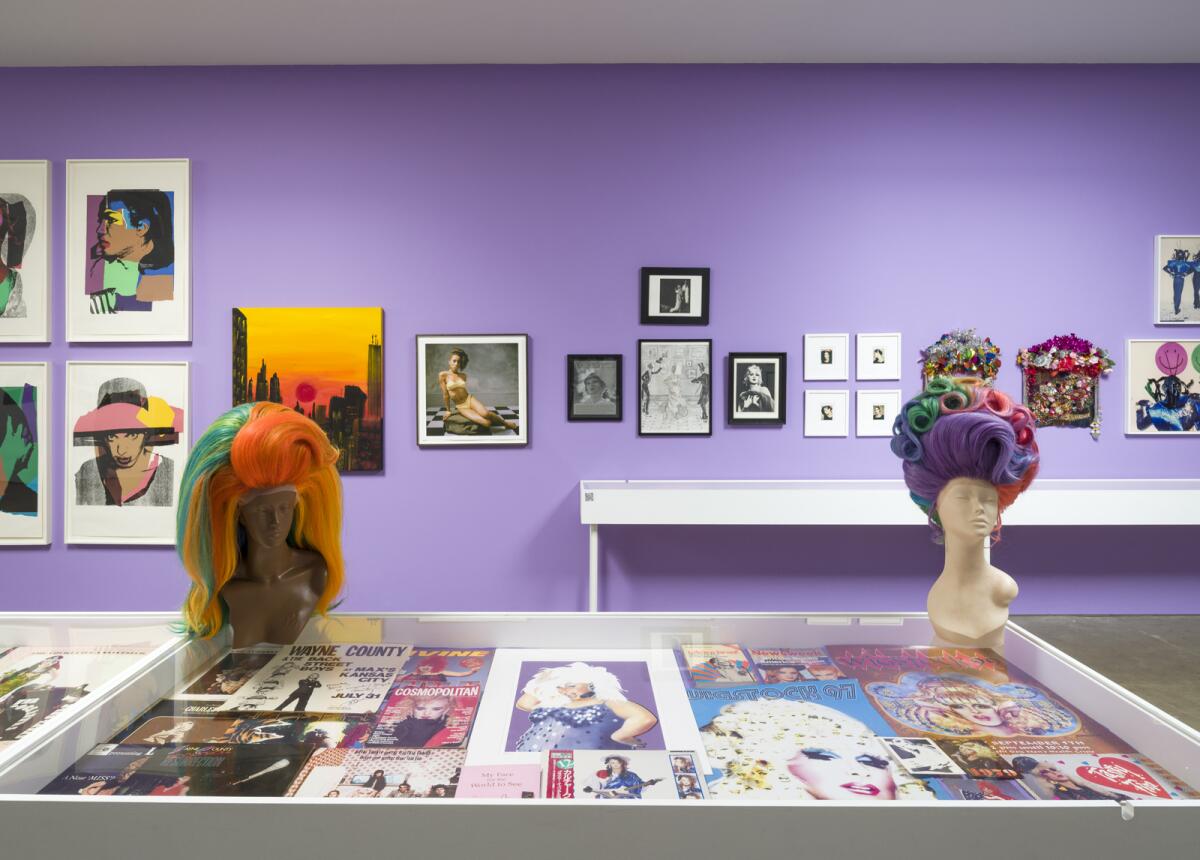
- Share via
Time to make the doughnuts — or, in my case, eat them. I’m Carolina A. Miranda, art and design columnist at the Los Angeles Times, with your weekly dose of essential arts news and the best maple cake:
The rest is drag
In her 2020 book, “Lurking: How a Person Became a User,” tech culture critic Joanne McNeil examines the rise of the early internet and, as part of that, the significance it had to queer culture — a place where a person questioning their sexuality might find answers or be able to present a truer version of themselves. “Members of the trans community speak of the internet more viscerally,” she writes, “because as a user, with options for anonymity and pseudonymity, it is possible to express an identity more ‘real’ and factual than what the physical world can see yet.”
An exhibition at Honor Fraser Gallery in Culver City looks at the inverse of that proposition, advocating “for a recontextualization of drag as a form of technology itself — applied queer knowledge accumulated, preserved, and reperformed across multiple generations and cultural terrains.” The group show, “Make Me Feel Mighty Real: Drag/Tech and the Queer Avatar,” curated by Jamison Edgar and Scott Ewalt, features work by a multigenerational group of more than 40 artists to examine notions of what the curators describe as “Drag/Tech.”

“Make Me Feel Mighty Real” takes its name from the hit disco-era single by Sylvester, the androgynous crooner with the falsetto voice whose well-known hit serves as an expression of queer love at its most ecstatically danceable. Its works span a variety of media: painting, photography, installation, video, digital animation and assemblage. Like a good drag show, the exhibition is messy and overstuffed, but punctuated with poignancy and wicked bite.
Across Honor Fraser’s gallery spaces, the show tells a story about the ways in which identity — particularly gender — is constructed and wielded, especially in the technological sphere. “Drag is a conscious outward construction representing an inner self,” wrote my colleague Christopher Knight in a recent column about why drag inflames the bigots. “It might mean a man in a dress or a woman in a suit and tie. But all those signifiers of gender are ultimately costumes, regardless of who puts them on.”
Make the most of L.A.
Get our guide to events and happenings in the SoCal arts scene. In your inbox every Monday and Friday morning.
You may occasionally receive promotional content from the Los Angeles Times.
To go forward, the show looks back. An early room focused on the 20th century features images of well-known performers such as Divine and Candy Darling, as well as L.A. artists Mundo Meza and Jef Huereque decked out in their “Drag Queens From Outer Space” ensembles. And there is plenty of intriguing ephemera, including a magazine called “Female Impersonators” and wigs by the performer known as Perfidia. (This room could have really used some acknowledgment of L.A.’s legendary and influential Cyclona.)
Also displayed is a collection of Andy Warhol prints from his “Ladies and Gentlemen” series, featuring trans women and drag performers. It’s an ambivalent piece, seeing as, until 2014, the figures in the works — which included activist Marsha P. Johnson and performer Wilhelmina Ross — went unnamed, presented more as archetypes than individuals. But the gathered portraits nonetheless serve as a historic honor roll. Supplementing the series is a 1981 image by Christopher Makos of Warhol himself in drag.
More striking is a 1987 portrait of Octavia St. Laurent by Josef Astor. St. Laurent was a trans model, entertainer and activist whose life was chronicled in the 1990 documentary “Paris Is Burning.” The image shows St. Laurent (who went by shifting monikers) perched on a banquette in a yellow bikini, looking the part of glamorous ’80s pinup. In the same gallery, you’ll find the absolutely hilarious and surreal “Tricia’s Wedding,” a 1971 film by Milton Miron that featured the Cockettes spoofing Tricia Nixon’s wedding — presidential nuptials as reimagined by hippie drag queens on acid. (Sylvester, who was part of the Cockettes in those days, makes an appearance.)
As Knight noted in his story: “Patriarchy puts straight men at the top of a social pyramid. Drag queens say, ‘Nope.’” There’s a lot of nope in this show.

As the exhibition moves into the present, you navigate a sequence of darkened galleries featuring a bounty of video and projections — so much that it can be hard to make sense of what’s what. But the overload is part of the fun.
This includes an array of hyperreal works, such as Angela Washko’s feminist interventions into the multiplayer online game “World of Warcraft” and Wesleigh Gates’ absurdist play/performance “A/B Machines,” an online drag play inspired by Warhol’s texts. I found myself inhaling Dynasty Handbag‘s “Garbage Castle,” from 2019, a spoof art-comedy about gentrification that is also a tale about the abjection of existing under capitalism — dire topics made funny by Handbag’s comedic muscle and puppet sidekick.
In a final gallery, Antigoni Tsagkaropoulou‘s soft vinyl sculptures, evoking oversized, spiked platform boots, serve as appealing signifiers of the tools of drag and drag as tool — pieces that are as tough as they are luscious. At a time in which we all build online personas and inhabit various digital avatars, this is a familiar space — one in which the outward construction of the self takes on additional layers. Is it a true self revealed through artifice? Or a glamorous layer of virtual armor piercing social mores and their attendant hypocrisies? I’d say all of the above.
The bigots won’t know what hit them.
“Make Me Feel Mighty Real: Drag/Tech and the Queer Avatar,” at Honor Fraser Gallery is on view through May 27; honorfraser.com.
On the stage
A stage musical loosely based on a Martin Scorsese film starring Robert De Niro and Liza Minnelli has landed at the St. James Theatre on Broadway. But “New York, New York,” writes Times theater critic Charles McNulty, comes off less as love letter than a musical that is simply “exhausting.”
McNulty, who has been in New York checking out the latest wave of Broadway offerings, also reviews a production of Doug Wright’s “Good Night, Oscar” at the Belasco Theatre, directed by Lisa Peterson. With Sean Hayes in the title role of curmudgeonly pianist Oscar Levant, the play, he writes, offers the actor plenty to chew on but it ultimately “traffics in TV tropes and formulas.”
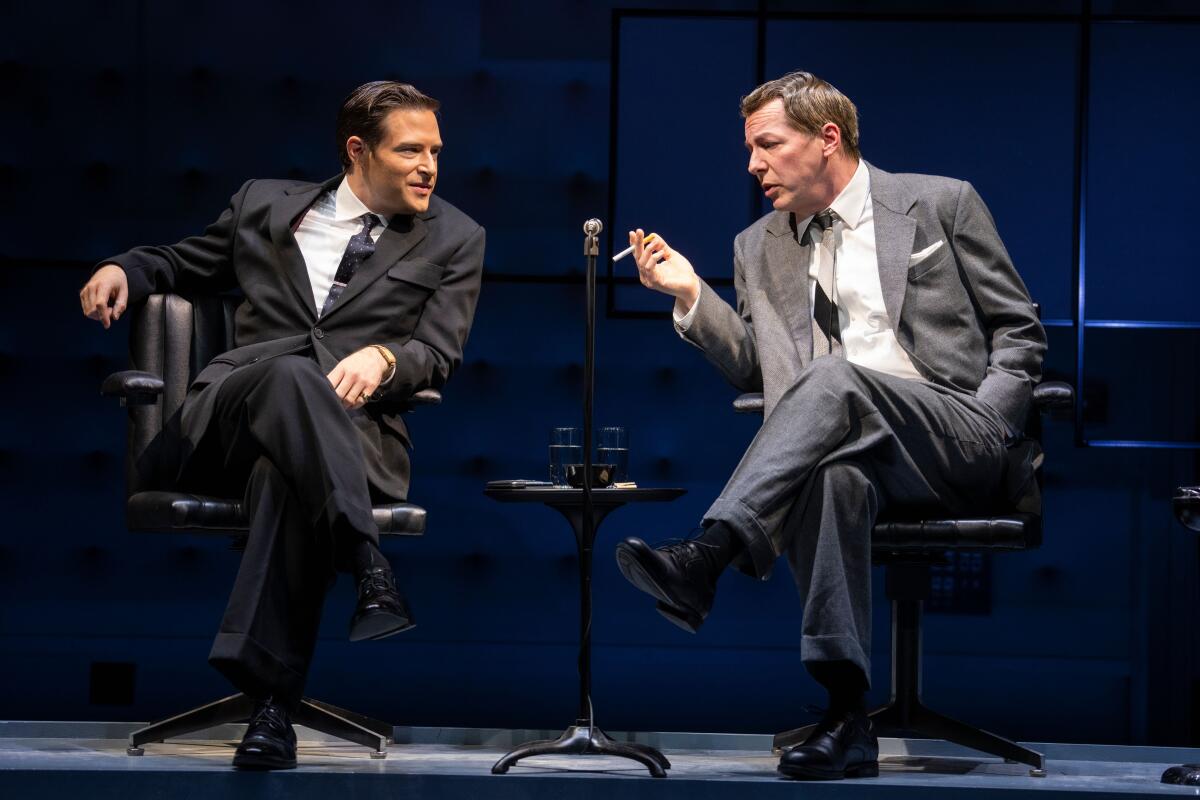
In and out of the galleries
Most art spaces have a hands-off policy, but artists Megan Whitmarsh and Carla Tome have created an installation titled “Many Hands Many Roads” that encourages touch. That’s because it’s a new sensory piece that recently debuted at the Braille Institute Los Angeles. “The challenge for us was to make it attractive, because some people are partially sighted,” Whitmarsh tells The Times’ Deborah Vankin, “and also diverse in its tactility.”
In 2008, the artist duo known as Los Jaichackers created a massive, steel-and-mirror sculpture for LACMA’s “Phantom Sightings” exhibition. Through a complicated chain of events, the sculpture turned up on the free section of Craigslist before ending up in the hands of a charismatic DJ and sound engineer from Michoacán, who turned it into a recording studio. Enrique Tena Padilla, a.k.a. DJ Escuby, takes me on a tour of a work he considers “evidencia mágica.”
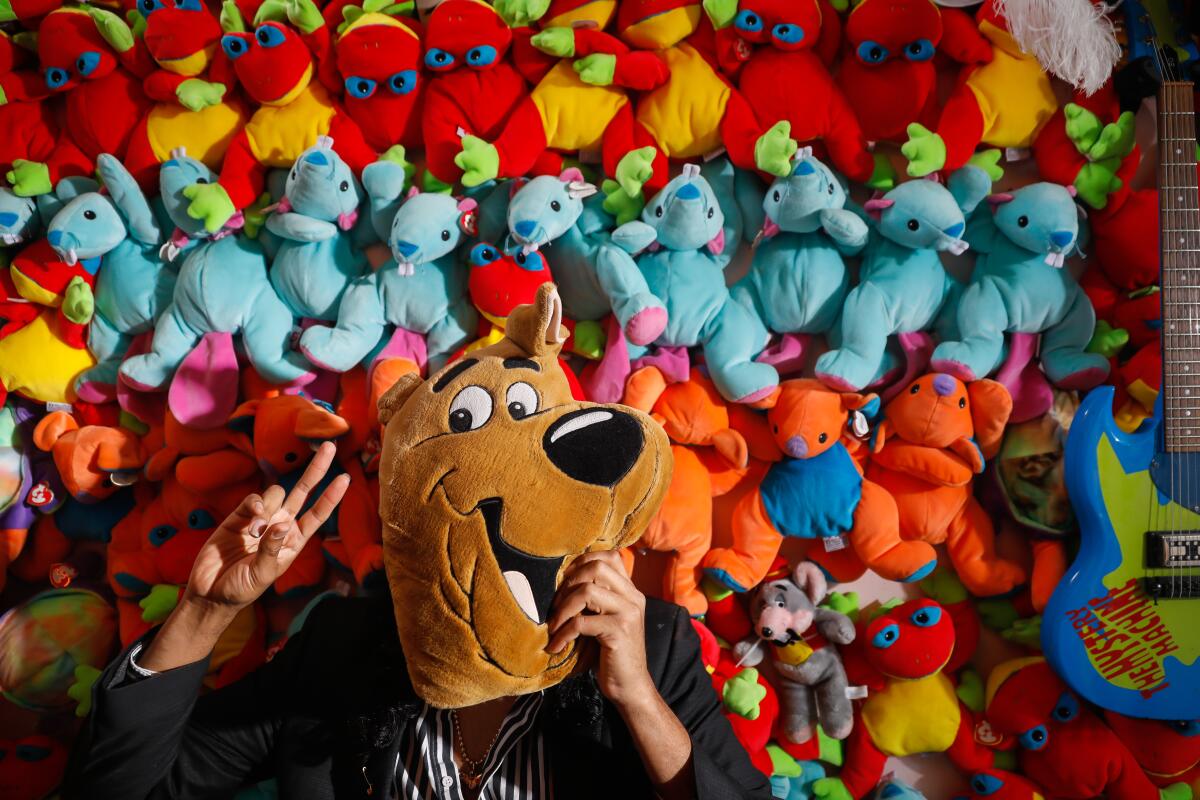
LACMA’s collectors committee raised more than $2 million and acquired 10 works of art. These include an ornate 17th century cabinet decorated with Peruvian silver and five historic barkcloth textiles from various Pacific islands, including a bedcover that once belonged to Hawaiian Queen Ka’ahumanu.
A popular Bellflower mural by Louis “Sloe” Paisino, showing Kobe Bryant, Oscar De La Hoya, Snoop Dogg, Tupac Shakur and Danny Trejo, has been threatened with removal because it violates city ordinances. (Murals, apparently, are supposed to face side streets, not majors.) In a region home to a renowned mural movement, the rules governing murals remain astonishing to me.
Just dance
L.A. Dance Project co-founder Benjamin Millepied has directed his first feature film, “Carmen,” which relocates the popular Bizet opera to the U.S.-Mexico border — and puts dance at the center of the story. “The movie uses dance as a narrative tool to advance the characters and plot forward,” writes Times culture writer Steven Vargas, “something that is rarely seen in a feature film.”
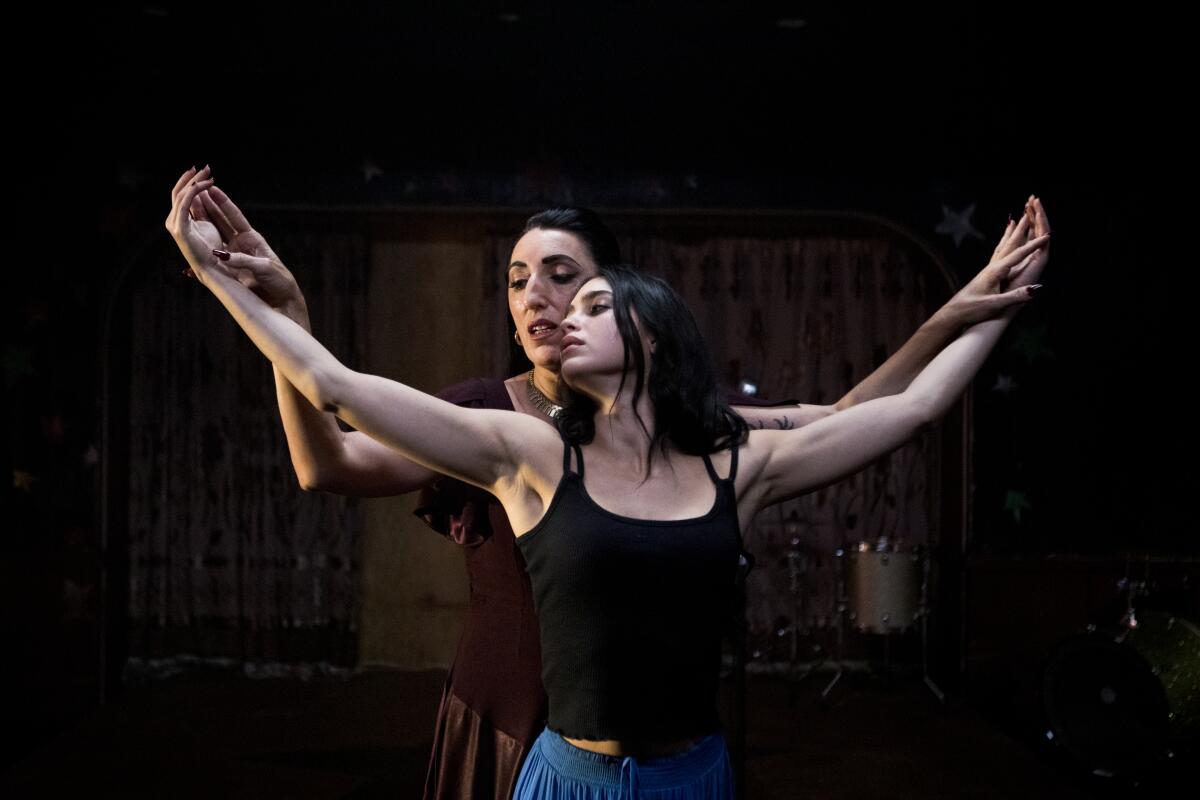
Design time
What happens to all the red carpet fashions after the party? A service called the Wardrobe founded by Julie Ann Clauss stores garments, bags, jewelry, shoes and other items for celebrities and fashion houses. Steven Vargas reports that the staging of Alexander McQueen’s “Savage Beauty” at the Met in 2011, which displayed everything from McQueen’s first postgraduate collection to his final runway show, helped inspire others to give garments archival care.
Enjoying this newsletter? Consider subscribing to the Los Angeles Times
Your support helps us deliver the news that matters most. Become a subscriber.
Two L.A. firms — Johnston Marklee and Michael Maltzan Architecture — are among the six finalists for the redo of the Dallas Museum of Art.
I’m here for L.A.’s “castlecore” architecture.
Essential happenings
As always, Steven Vargas has a digest of the top events in his L.A. Goes Out newsletter, including a performance by Autumn Breon at Hauser & Wirth on Saturday that is inspired by a history of community organizing within Black hair salons.
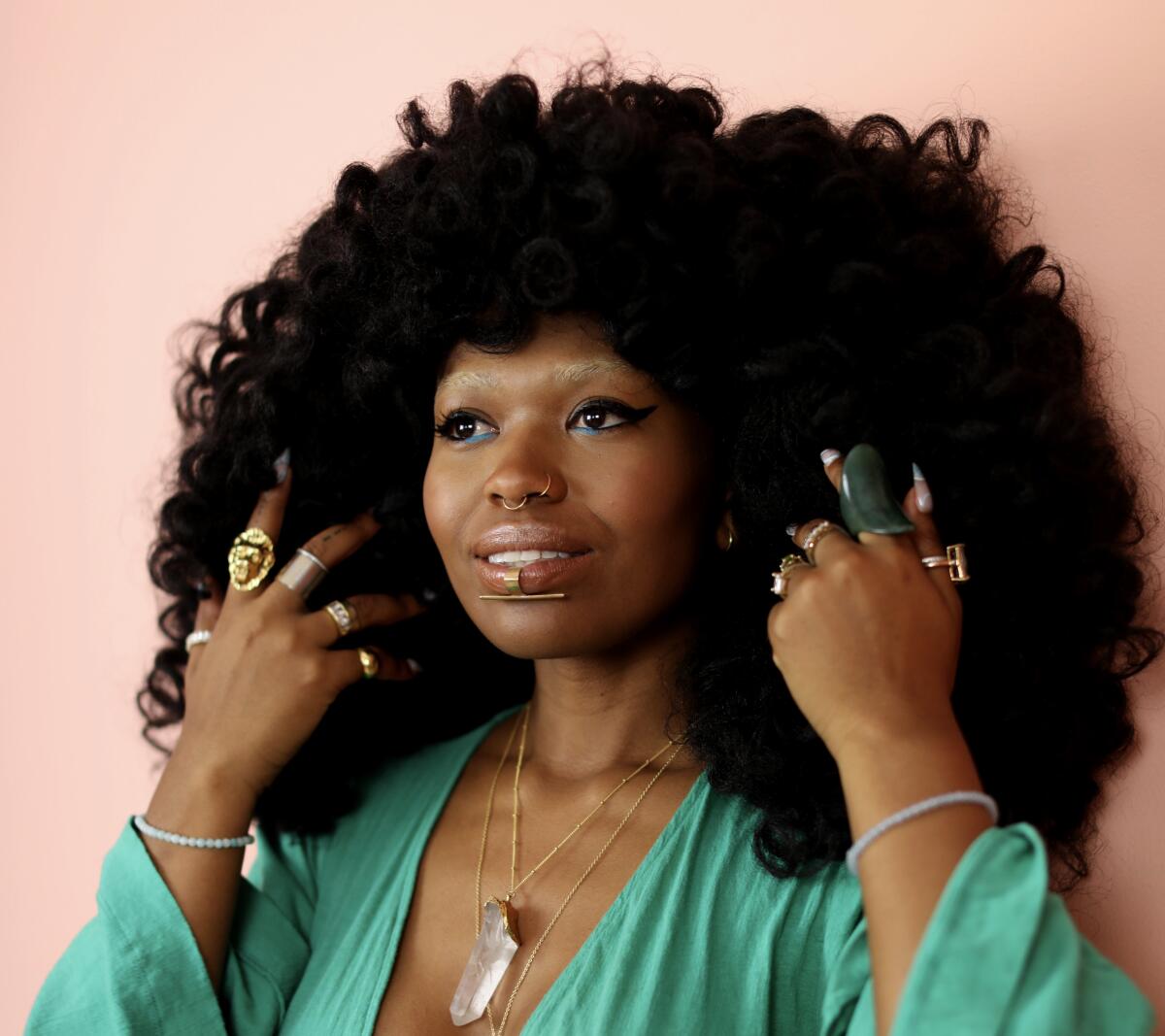
And Matt Cooper has all of the happenings around L.A. organized by neighborhood, including performances by the Paul Taylor Dance Company at the Dorothy Chandler Pavilion.
Moves
The Huntington has commissioned an installation from Betye Saar for its Virginia Steele Scott Galleries of American Art. The work is tentatively titled “Drifting Toward Twilight.”
Claudia Flores has been named president of the board of directors at the Institute of Contemporary Art Los Angeles, the first person of Mexican origin to occupy the role.
The American Academy in Rome has announced the latest class of fellows for its prestigious 2023-24 Rome Prize. It includes seven visual artists — among them, L.A. performance and installation artist Nao Bustamante. Find the full list here.
The Academy also has a new president and CEO: historian Peter N. Miller, who joins the organization from the Bard Graduate Center. He replaces outgoing director Mark Robbins, who is stepping down after nearly a decade.
Passages
Designer Jane Davis Doggett, who helped pioneer systems of environmental graphic design (also known as wayfinding) for megaprojects such as airports, has died at 93.
Pianist and composer Karl Berger, who played with jazz musicians such as Dave Brubeck and Ornette Coleman and led the Creative Music Studio near Woodstock, N.Y., is dead at 88.
This week, Carolyn Bryant Donham, a woman whose allegations led to the brutal lynching of Emmett Till, died at the age of 88. As art writer and critic Colony Little has pointed out, this makes it a good time to revisit a 2015 essay by Ellen J. Caldwell on a 2002 work by Kerry James Marshall that explores the legacies of lynching.
In the news
— “Succubus chic.”
— Climate protesters smeared paint on a vitrine featuring Edgar Degas’ “Little Dancer Aged Fourteen” at the National Gallery of Art in Washington, D.C.
— In her book, “Monsters: A Fan’s Dilemma,” Claire Dederer considers how to reconcile art and artist when the artist is a big jerk.
— A dispatch from the world of art merchandise.
— Ben Davis has an interesting column about how AI has expanded “a kind of anti-creativity: the ability to rip-off, band-wagon jump, and hijack the idea of anyone who manages to do something noticeably original.” (Don’t miss the video at the bottom of the post.)
— Big in Japan: anime-inspired cars.
— That over-the-top Norwegian hotel featured in the most recent episode of HBO’s “Succession” is called the Juvet Landscape Hotel and was also used as a location for “Ex Machina.”
— ICYMI, this story by my colleague Gale Holland, about the razing of a multiracial Palm Springs neighborhood for “slum clearance” in the 1950s and ’60s is just harrowing.
— New York Times architecture critic Michael Kimmelman is really digging Studio Gang‘s redo of New York’s Museum of Natural History.
— The most targeted books in the U.S. in 2022.
And last but not least ...
This very long thread maintained by @VitruviusGrind that lists the factual inaccuracies and historical inconsistencies put forth by the trad architecture types.
The biggest entertainment stories
Get our big stories about Hollywood, film, television, music, arts, culture and more right in your inbox as soon as they publish.
You may occasionally receive promotional content from the Los Angeles Times.




